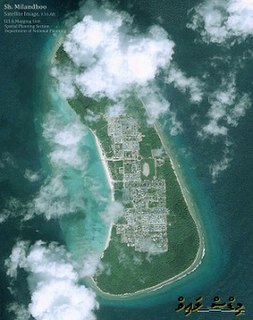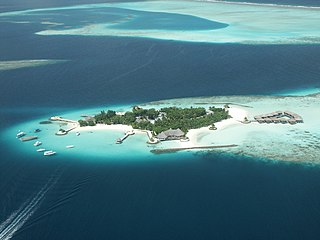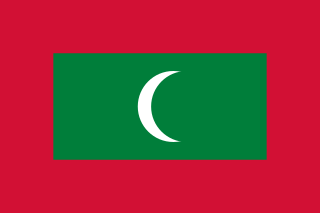Fonadhoo is the capital island in Laamu atoll of the Maldives.
Fulidhoo (Dhivehi:ފުލިދޫ) is the most northern of the inhabited islands of Vaavu Atoll in the Maldives. It is famous for Maldivian cultural events like Langiri, a traditional dance with drums and Thaara.
Gui Manadhoo is the capital of Noonu Atoll in the Maldives. Manadhoo is the most populous island and the largest natural island in Noonu Atoll.
Bileffahi is one of the inhabited islands of the Shaviyani Atoll administrative division and geographically part of the Miladhummadulhu Atoll in the Maldives.
Feevah is one of the inhabited islands of Shaviyani Atoll administrative and geographically part of the Miladhummadulhu Atoll in the Maldives.
Feydhoo is one of the inhabited islands of the Shaviyani Atoll administrative division and geographically part of the Miladhummadulhu Atoll in the Maldives. Feydhoo is located in the centre of the atoll between the channel called Noomara Kandu and the island of Bileffahi.
Foakaidhoo is one of the inhabited islands of the Shaviyani Atoll administrative division and geographically part of the Miladhummadulhu Atoll in the Maldives.
Goidhoo is one of the inhabited islands of the Shaviyani Atoll administrative division and geographically part of the Miladhummadulhu Atoll in the Maldives.
Kanditheemu is one of the inhabited islands of Shaviyani Atoll administrative and geographically part of the Miladhummadulhu Atoll in the Maldives.
Lhaimagu is one of the inhabited islands of the Shaviyani Atoll administrative division and geographically part of the Miladhummadulhu Atoll in the Maldives.
Maaungoodhoo is one of the inhabited islands of the Shaviyani Atoll administrative division and geographically part of the Miladhummadulhu Atoll in the Maldives.

Maroshi is one of the inhabited islands of the Shaviyani Atoll administrative division and geographically part of the Miladhummadulhu Atoll in the Maldives.

Milandhoo is an island in the Shaviyani Atoll administrative division of the Maldives and geographically part of the Miladhummadulhu group in Thiladhunmati Atoll.
Ihavandhoo is an inhabited island in Maldives. It is located in the northern-most geographic atoll in the country, and is administratively part of Haa Alif Atoll. It is an island-level administrative constituency governed by the Ihavandhoo Island Council.

Hulhumeedhoo or Hulhudhoo-Meedhoo is an island located on the northeastern point of Addu City. Even though it is the 5th largest island in the Maldives, Hulhumeedhoo has roughly the land area of New York's Central Park. Although Hulhumeedhoo is geographically one island, it is divided into two administrative constituencies of Addu City, known as Meedhoo and Hulhudhoo, which are roughly the northern half and southern half of Hulhumeedhoo respectively. The name "Hulhumeedhoo" is an amalgamation of the names Hulhudhoo and Meedhoo.

The fishing industry in the Maldives is the island's second main industry. According to national tradition in the words of former President Maumoon Abdul Gayoom, "Fishing is the lifeblood of our nation, it is inborn. From the soil on which we live, to the sea around us, it remains an integral part of our existence. Fishing, and our country and its people, [are] one and shall remain inseparable forever." The Maldives has an abundance of aquatic life and species of fish. Common are tuna, groupers, dolphin fish, barracuda, rainbow runner, trevally and squirrelfish and many more. Aside from being of essential importance to the economy, fishing is also a popular recreational activity in the Maldives, not only among locals but by tourists. The islands have numerous fishing resorts which cater for these activities.

Letter Shaviyani is the second letter of the Thaana abugaida- the writing system used in Dhivehi language of the Maldives and Minicoy Island.








